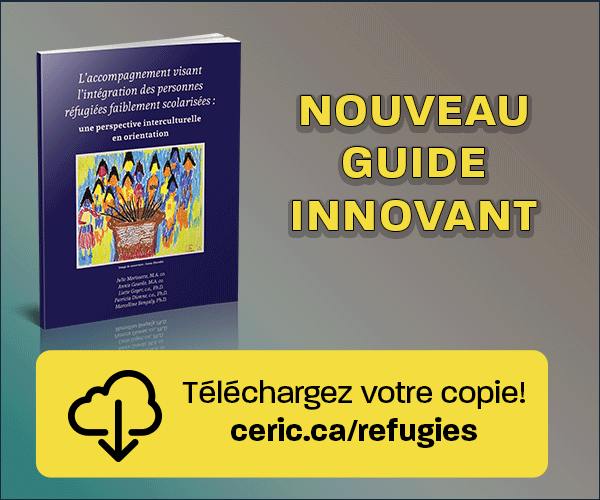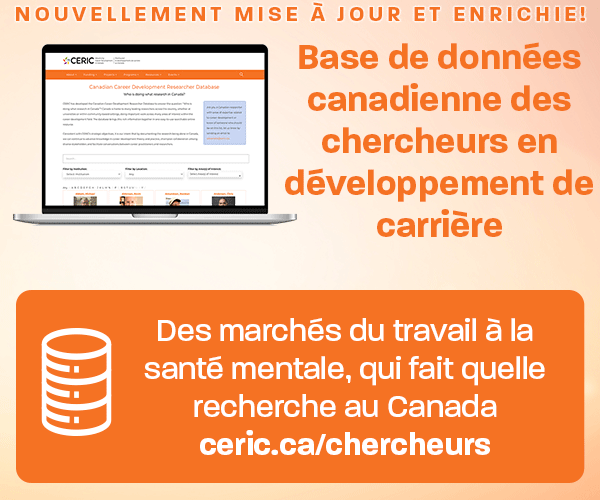L’orientation professionnelle avec les étudiants des collèges communautaires : l’application d’une approche narrative
Mots-clés :
orientation professionnelle, carrière, conseil, collège communautaire, étudiants, récitRésumé
Due to changes in the economy and therefore in the workplace, increasing numbers of students are attending community colleges. The applicability of traditional career counselling models for today’s students is questioned, and a narrative approach is proposed as uniquely situated to complement and enhance existing practices. Many narrative interventions, such as the writing of therapeutic documents and the identification of “guides,” mimic the community college culture, with its homework assignments and program advisors. Use of metaphor is a helpful tool for work with many types of clients represented at community colleges such as young adults and those from other cultures, and the strengthsbased nature of this approach can help reduce acculturative stress. Lastly, the holistic examination afforded by a narrative approach can help illuminate potential internal or external client factors that may impact career decisionmaking.
Références
Amundson, N. (2014). In Hartung, P., Savickas, M.L., & Walsh, B.W. (Eds).Using Metaphor in Career Intervention. APA Handbook of Career Intervention.
Amundson, N.E. (2009). Active engagement: The being and doing of career counselling. (3rd Ed). Richmond, B.C.:Ergon Communications.
Anderson, E. (2013). Stop saying career “path.” Career Convergence Magazine. Retrieved June 9, 2013 from http://ncda.org/aws/NCDA/t/sp/career_convergence_ind_articles
Bandura, A. (2002). Growing primacy of human agency in adaptation and change in the electronic era. European Psychologist, 7 (1), 2-16.
Brouwers, M. (1994). Bulimia and the relationship with food: A letters-to-food technique. Journal of Counselling Development, 73, 220-222.
Campbell, C. & Ungar, M. (2004). Constructing a life that works: Part 2, an approach that works. Career Development Quarterly, 53, 29-40.
Epston, D., & White, M. (1990). Narrative Means to Therapeutic Ends. Dulwich Centre: Adelaide, South Australia.
Epston, D., Stillman, J.R., & Erbes, C.R. (2012). Speaking two languages: A conversation between narrative therapy and scientific practices. Journal of Systemic Therapies, 31 (1) 74-88.
Erikson, E. (1968). Identity: Youth and Crisis. New York: W. W. Norton Company
Holland, J.L. (1970). Self-Directed Search. Palo Alto, CA: Consulting Psychologists Press.
Jarvis, P. & Sadlowski, L. (2010). Perfect storm to hit job markets. Retrieved May 2,2013 from http://public.careercruising.com/pdfs/Perfect_Storm_Rationale.pdf
Kadison & DiGeronimo Foy (2004). College of the Overwhelmed: The Mental Health Crisis on Campus and What to Do About It. John Wiley & Sons: San Francisco, CA.
Koyama, C. & Belli, G. (2011). Alcohol use, acculturative stress, and drinking motivation among international community college students. Journal of Multicultural
Counseling & Development, 39 (4) 229-240.
Kress, V. E., Gimenez Hinkle, M., & Protivnak, J. J. (2011). Letters from the future: Suggestions for using letter writing as a school counselling intervention. Australian Journal of Guidance and Counselling, 21 (1), 74-84.
Harder, N.J. (2011). Internationalization efforts in United States community colleges: A comparative analysis of urban, suburban, and rural institutions. Community College Journal of Research and Practice, 35, 152-164.
Luzzo, A. (Ed). (2000) Career Counseling with College Students: An Empirical Guide to Strategies that Work. American Psychological Association: Washington, DC.
Martin, D.G. (2003). Clinical Practice with Adolescents. Brooks-Cole: Belmont, CA.
McMahon, M. & Watson, M. (2012). Telling stories of assessment. Journal of Career Assessment, 20 (4). 440-451.
McPherson, J. (2011). Does narrative exposure therapy reduce PTSD in survivors of mass violence? Research on Social Work Practice, 22 (1), 29-42
Morgan, M., Brosi, W., & Brosi, M. (2011). Restorying older adults’ narratives about self and substance abuse. The American Journal of Family Therapy, 39,444-445.
Piaget, J. (1929). The Child’s Conception of the World. New York, NY: Harcourt,
Brace Jovanovich. Poehnell, G. & Amundson, N. (2002). CareerCraft: Engaging with, energizing, and empowering career creativity. In Peiperl, M., Arthur, M, Goffee, R., & Anand, N. (Eds.) Career creativity: Exploration in the remaking of work. (pp 105-122). Oxford, UK: Oxford University Press.
Ramachandran, V.S., & Hubbard, M. (2005). Hearing colours, seeing shapes. Scientific American Mind, 16 (3), 16-23
Rehfuss, M.C. & Di Fabio, A. (2012). Validating the Future Career Autobiography as a measure of narrative change. Journal of Career Assessment, 20 (4), 452-462.
Roth, S. & Epston, D. (1996). Developing externalizing conversations: An exercise. Journal of Systemic Therapies, 15(1), 5-12.
Skinner, B.F. (1989). The origins of cognitive thought. American Psychologist, 44 (1), 13-18.
Watt, K.M., Huerta, J., & Alkan, E. (2012). Advancement via individual determination (AVID) in a community college setting. Community College Journal of Research
and Practice, 36, 752-760.
Yakunina, E.S., Weigold, I.M., Hercegovac, & Elsayed, N.(2013). International students’ personal and multicultural strengths: Reducing acculturative stress and promoting adjustment. Journal of Counseling & Development, 91 (2) 216-223.

Téléchargements
Publié-e
Comment citer
Numéro
Rubrique
Licence

Cette œuvre est sous licence Creative Commons Attribution - Pas d'Utilisation Commerciale - Pas de Modification 4.0 International.











